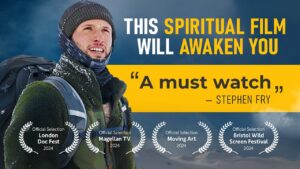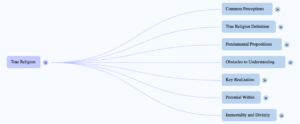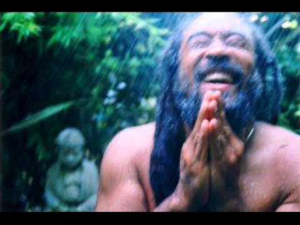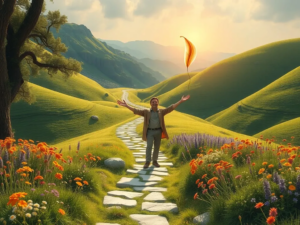
Angst, restlessness etc…
“Until thought is understood – better yet, more than understood, perceived – it will actually control us; but it will create the impression that it is our servant, that it is…

The Subtle Art of Losing Yourself (Documentary)
The Subtle Art of Losing Yourself
The Subtle Art of Losing Yourself
Full Life Changing Documentary
Introduction
- The great teachers of history have taught the importance of self-awareness, promising that understanding who we really are will bring wisdom and with wisdom, we can live in peace (00:00:16).
- Living in peace is hard, but through trying to be less confused and anxious, humanity has discovered some helpful things about who we are that have helped feel more grounded, less confused (00:00:46).
- The idea of exploring and understanding ourselves through our own intuition, rather than relying on other people, is a key aspect of this journey, and being in nature can teach us about our own nature (00:01:05).
- When in the city, the animals that are typically seen are pigeons, seagulls, and everyone’s pets, but being in the Scottish wilderness allows for observation of animals surviving, and this sparks an appreciation for the extraordinary miracle of life on planet earth, and the emotions and experiences that other species have (00:02:25).
Animals and Emotions
- The concept of looking at animals to understand ourselves may be unconventional, but if animals can feel emotions like fear, and care for family, then this can teach us about our own feelings, and where we come from (00:02:59).
- Historically, philosophers like Descartes that animals had no mind at all, and were just unconscious machines, which justified gruesome experiments on live animals, and led to the belief that only humans had minds or spirits (00:03:47).
- Descartes’ ideas created splits in how we understand ourselves, including the separation of our minds and bodies, and the distinction between humans and nature, leading to the belief that only humans are intelligent or sacred (00:04:50).
- The subsequent development of science got rid of the concept of spirits and sacredness, but kept the idea that rational thinking minds are the only intelligence in the universe, resulting in a feeling of isolation (00:05:15).
- The idea that our thinking is the source of our identity and what makes us different from animals is explored, and an exercise is suggested where individuals can rub their fingertips together to experience sensations without thoughts, highlighting that experiences are not just about thoughts with words, but also about direct sensations and emotions (00:06:01).
- By paying attention to our own experiences, it is found that “I think therefore I am” can only be part of the story of who we are, and “I feel therefore I am” is also an essential part of being human, allowing us to reconnect with the fact that we are not just our thoughts (00:06:54).
Finding Peace Through Tai Chi
- A personal story is shared about descending into confusion and anxiety after finishing education, and finding peace through the practice of Tai Chi, a moving meditation that allows individuals to experience being in their feelings and sensations without words, and to realize that they are not just their thoughts (00:07:12).
- The practice of Tai Chi and other forms of meditation can help individuals to understand that they are not just their thoughts, and that sensations are an option, allowing them to find peace and to observe their experiences in a new way (00:07:43).
Our Shared Genes and Experiences
- Observing animals can teach us about their consciousness, creativity, and intelligence, and science has found that animals share many of the same genes as humans, with 80% of the genes in human DNA also found in squirrels, and 50% of human genes also found in celery (00:08:27).
- The understanding of ourselves and our place in nature is still at the start, and it is recognized that we share our experiences, emotions, and intelligence with the rest of life, and that our ability to think and reason is not the only thing that distinguishes us from animals (00:09:37).
The Origins of the Human Mind
- The origins of the human mind are explored, and an ancient burial ground from the Bronze Age is visited, which shows that people 4,000 years ago had brains capable of complex thinking and were able to create stories and motivate their community to come together to create complex structures (00:11:05).
- Evidence suggests that the ability to storytelling is not unique to Homo sapiens, as other species, including Neanderthals, have demonstrated complex behaviors and emotions, such as burying their dead with care and decorating themselves with feathers (00:11:39).
- The Neanderthals lived in communities, made their own clothes, created tools, and wore decorations, indicating a level of cognitive and emotional complexity, and their burial sites often featured multiple skeletons, including those of different ages, with some bodies surrounded by symbolic items like antler horns and rhinoceros skulls (00:12:04).
- The discovery of Neanderthal burials and the presence of ritualistic behaviors, such as the deliberate placement of stalactites and stalagmites in circles, suggests that these early humans may have had a level of self-awareness and emotional experience similar to that of modern humans (00:12:57).
- The example of elephants, which exhibit complex emotional behaviors like grief when one of their troop members passes away, demonstrates that ritualistic behaviors can be motivated by emotions alone, without the need for complex ideas about life after death (00:13:04).
- The 2013 discovery of a complex structure in a French cave, featuring hundreds of deliberately placed stalactites and stalagmites, and the remains of fires, has been dated to 174,000 years old, implying that Neanderthals were capable of creating complex and symbolic structures (00:13:49).
- The presence of such structures and the emotional experiences of Neanderthals and other animals challenge the idea that human intelligence and consciousness are unique, and instead suggest that these abilities may be more widespread in the natural world (00:15:20).
- The question of where human intelligence comes from has led to a broader inquiry into the nature of consciousness and how it arose on Earth, with the fossil record indicating that life began billions of years ago and gradually became more complex, eventually giving rise to emotional experiences, thoughts, and basic language in some animals (00:15:38).
- The evolution of life on Earth, from simple organisms to complex animals, has been marked by the emergence of emotions, such as fear and care, and eventually, the development of thoughts and basic language, allowing some animals to interpret and tell stories about their experiences (00:16:07).
Human Intelligence and Spirituality
- Humans have developed advanced language, leading to an explosion of power and many questions, and every human culture has some form of spirituality or religion to help satisfy natural curiosity and understand who we are and what we are a part of (00:16:36).
- Understanding ourselves requires humility, and through observation, we can determine some principles that shape us and the universe, with science being a process of observation, making predictions, collecting evidence, and seeing what the evidence tells us (00:17:18).
- Science has led to an understanding that many wisdom traditions share, which is that all of us, regardless of religion, nationality, gender, or species, come from the same mysterious source, and recognizing this can help overcome the barrier of disconnection (00:17:48).
Reconnecting with Our Source
- To find peace, it’s essential to shift focus and reconnect with what we are a part of, recognizing that we are made from the same energy that created humans, plants, animals, and the planet Earth (00:18:17).
- We are embodied awareness, with mind and body coming from the same mysterious source, and we have two main ways of experiencing and understanding ourselves: the sensor, which is the complex array of emotions and sensations, and the storyteller, which watches and narrates our experiences (00:18:51).
- The storyteller creates stories about who we are using thoughts, and understanding how it works can be life-changing, as it reveals that our sense of identity is constructed from thoughts that we identify with, and that there’s nothing intrinsically true about these stories (00:19:04).
- Recognizing the storyteller’s role can help us laugh at the tragedy of creating pain in our lives from stories that are only true to the extent that we identify with and believe the thoughts that pop into our heads (00:20:09).
- Practicing mindfulness, such as taking a mindful breath, can help create a space to choose our response to thoughts and stories, and can be a beautiful way to bring pause and curiosity into our daily lives (00:21:18).
- The practice of pausing and bringing curiosity to painful thinking can create space within, which is considered freedom, and this realization is a crucial step on the journey towards peace (00:22:00).
The Power of Storytelling and Habits
- Understanding oneself is not enough to achieve peace, as even with insight, one can still fall back into old habits, such as scrolling through social media and feeling lost, highlighting the need for continuous practice and transformation (00:22:40).
- The creation of one’s own stories through thoughts and identification with them can lead to negative storytelling, and it is essential to recognize that inner peace can be challenging to achieve due to these habits (00:23:44).
- The brain’s neural pathways are strengthened by repeated behaviors, making habits, such as worry, a dominant way of thinking, and it is crucial to acknowledge and address these habits to transform them into wisdom (00:24:22).
- A personal example of the habit of worry is the “Underminer,” a character that dominated one’s storytelling headspace, channeling life events through negativity and worry, leading to feelings of hopelessness (00:24:56).
- To overcome such habits, it is essential to stop digging oneself into a hole and instead practice self-compassion, love, and kindness, recognizing that being hurt does not make one weak or flawed (00:25:48).
- Acceptance of one’s current situation is vital on the journey towards peace, but it is also important to find more empowering ways to respond to life’s challenges, rather than getting stuck in negative patterns (00:26:16).
- The concept of wisdom is derived from the root “to see” and is often associated with spiritual places like mountains, where one can gain perspective and choose how to respond to life, channeling experiences towards harmony and peace (00:26:51).
- The stories that empower individuals need to be discovered by themselves, and change, whether big or small, is possible with patience, persistence, and kindness, and this realization can be applied to life by responding to challenges with courage and resilience (00:27:20).
Embracing Change and Losing Oneself
- Change can be scary, which is why people crave certainty about how the world works and who they are, but the only constant is change, and this applies to everything, including the weather on a mountain and human beings themselves (00:28:27).
- Finding oneself is important, but it is also necessary to develop the subtle art of losing oneself, surrendering to the ever-changing flow, and embracing the mystery of one’s being, which can be achieved by not needing a story and resting in the present moment (00:29:35).
- The stories of who people are are created from the thoughts that pop into their heads, and they have the freedom to choose a story that empowers them, but they and the world are always changing and too complex to fully capture with words (00:30:05).
- One of the most reliable ways to lose oneself is by being in nature, such as walking in landscapes bigger than oneself, which can help soften the mind and find moments of no thought, allowing individuals to connect with a simple presence, ease, and connection (00:30:38).
The Importance of Meditation
- The intelligence of the universe has achieved great things, and all technology is still nature expressing itself, but the modern world brings big challenges, and living with wisdom and peace requires practices to help stay in connection with one’s wiser self (00:32:03).
- To live with wisdom and peace, it is necessary to steady one’s awareness, rest, and see oneself clearly, which can be achieved through practices such as meditation, and this is important because the default setting of human consciousness is to flit between craving and distractions, making it hard to stay conscious (00:32:52).
- Meditation is about presence, and it involves training awareness to rest and find presence more easily, which has been discovered and practiced all around the world throughout history, and it can help individuals live in peace in their everyday lives (00:33:23).
- To practice meditation, individuals can sit in any way they like, close their eyes, and focus on their breath, noticing where it is and slowing it down, while also softening any tension in their face, forehead, or jaw (00:34:04).
- The sensation of the breath is part of one’s sensor, and it allows individuals to rest in their sensations, rather than just their thoughts, and to kindly watch their breath coming in and out, noticing any thinking that arises without judgment (00:35:01).
- Meditation is not about having a quiet mind, but rather about the process of returning to the present moment when the mind gets lost in thought, and it involves gently coming back to the breath without judgment (00:35:55).
- The goal of meditation is not to improve oneself or achieve a specific state, but rather to hold openness and space for its own sake, without expectations or attachments, and to rest in the present moment (00:36:39).
- Regular meditation practice can help individuals develop kindness, spaciousness, and awareness, which can be brought into everyday life, allowing them to respond to challenging situations with more curiosity and understanding, rather than reactivity (00:37:54).
- By applying the practice of meditation and pausing in daily life, individuals can reconnect with nature, feel more resilient and joyful, and develop a greater sense of awareness and understanding, even in the face of challenges and difficulties (00:39:25).
Peace and Global Well-being
- However, true peace requires more than just individual meditation practice, as it is also influenced by the well-being of loved ones, the state of the world, and the presence of global challenges, such as war and climate disasters (00:39:50).
- Understanding oneself is crucial for achieving peace, not only within oneself, but also in relationships, communities, countries, and the planet, as it leads to wisdom and a life of peace (00:40:05).
- The economic and political systems that shape the world are built upon stories, assumptions, and narratives about what it means to be human, which are agreed upon and given power by people (00:40:53).
- Believing in one’s own capacity for healing, forgiveness, and cooperation can lead to a different world, where people find contentment and richness in simplicity, rather than exhausting their energy chasing external happiness (00:41:19).
- Understanding oneself matters because it creates resilience and peace, inspiring others that change is possible, and can lead to a collective transformation of the systems that shape the world (00:41:54).
- Recognizing one’s connection to the universe and the planet can evoke feelings of love and a desire to be part of a movement that seeks to protect and celebrate the flourishing of life (00:42:21).
The Journey to Peace and Resources
- The journey to peace and balance is not about perfection, but about taking small steps and supporting each other, and giving oneself permission to strive for better (00:43:07).
- For those who want to continue exploring the ideas and practices presented, there are resources available, including a free email course, events, and online courses, such as the Taoist Wellness Online program with Master Gu (00:44:33).
- The community that has supported the creation of the film is appreciated, and balance and peace are possible for those who continue on their journey (00:44:56).

The Foundation Of Religion
Robert Crosbie (1849-1919) “It is our minds, which we have filled with narrow ideas of life, with small ideas of the nature of humanity and of ourselves. It is our…

The silence of noise
KAT: “I fell for the idea that calm surroundings and a silent mind were requirements. What nonsense. The body sits in the passenger seat. There’s engine noise, noise from dense…

Joy is not the monopoly of the mind.
Your entire being is synonymous with joy. But enjoy being free at the highest level. One is only enjoying oneself.

Friendship and the joy of living ❤️
“Magdi emphasizes that finding and having friends is part of the health of the organism, comparing it to the necessity of food, water, and shelter. He also notes that we…
